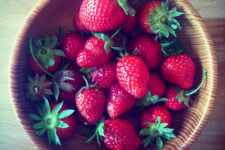There’s nothing better than finding a pint of perfectly ripe strawberries. Just the right combination of sweet and tangy with a firm, slightly juicy texture that leaves you begging for more.

Strawberries this perfectly ripe can’t be found just any time of year. They only grace the shelves of your local grocer or farmer’s market when strawberries are in peak season.
In general, strawberries grown in the US are in season from May to October. But finding that perfect pint requires narrowing this period based on the variety of strawberries you’re after and the region you live in.
Below, we’ll discuss peak strawberry season based on these important factors. We’ll also give you our tips for finding strawberries out of season, preserving strawberries for year-round enjoyment, and using fresh strawberries in our favorite recipes.
Strawberry Varieties & Their Respective Seasons
Strawberry varieties are generally separated into three categories: everbearing, June-bearing, and day-neutral. You can easily discern when the strawberry variety will be in peak season based on which category it falls into.
Everbearing Strawberries
Despite that optimistic name, everbearing strawberry varieties don’t actually produce strawberries all season long. Instead, they tend to produce two crops, one in the spring and one in the fall.
The first harvest for everbearing strawberries typically occurs in mid-May. The second typically happens in August or September. Some varieties that produce an early yield in August will also produce another in October if conditions permit.
Some common varieties of everbearing strawberries include Ft. Laramie, Ozark Beauty, Quinault, Ogallala, Gem, and Rockhill.
June-Bearing Strawberries
As the name suggests, June-bearing strawberries typically hit peak season in June. Which part of June, though, depends on whether the plant is an early, mid, or late-season variety.
Early-season plants will start setting fruit in late May or the first week of June. Midseason varieties start setting fruit the second week of June. And The late-season plants are ready to harvest starting around mid-June.
All these plants typically produce for about two weeks. This means you can find June-bearing strawberries in peak season for the entire month of June.
Some common varieties in this category include Earliglow, Chandler, Early Glow, Honeoye, Allstar, and Jewel.
Day-Neutral Strawberries
Day-neutral strawberries are unique in that they produce fruit for an extended period each season. The price for this long-term harvest, though, is much smaller fruit. Day-neutral strawberries tend to be under an inch in size and, for that reason, aren’t typically found in grocery stores.
These productive plants start setting fruit in July. They will continue to produce strawberries until the first frost makes them go dormant, which typically happens in October.
Popular day-neutral varieties include Sweet Ann, Portola, Cabrillo, Albion, Monterey, San Andreas, and Seascape.

Peak Strawberry Season by Region
If you happen to live in a mild climate where all three of these strawberry types thrive, you might be lucky enough to get strawberries at peak ripeness all summer long. For the rest of us, finding the perfect pint of sweetness means knowing when varieties in your region are most likely to be setting fruit.
Northeast
Thanks to plentiful day-neutral and June-bearing plants, the northeast is privy to fresh strawberries from late May through June. Smaller fruits will continue to be available at farmer’s markets well into fall.
Southeast
Due to a warmer climate that allows for early production, residents of Southeastern states can find strawberries in peak season starting as early as March. The season typically hits its highest yields in June. A third wave of strawberries often hits in late summer with a potential for a fourth in fall, wherever ever-bearing strawberries are grown.
Midwest
The Midwest sees strawberries in season from late spring through June, with June-bearing varieties offering the most fruit. In general, strawberry season here is shorter compared to other regions, but it is possible to find day-neutral and ever-bearing varieties producing through the summer into early fall.
Southwest
Warmer parts of the Southwest can see their first crop of strawberries as early as February. But most here will enjoy peak season production between mid-May and July. Late crops are less likely in colder, higher-elevation regions, but are common deeper to the south.
West
Strawberries typically start producing in mid-spring in the West. They will continue with peak season hitting in June and day-neutrals filling the gap until ever-bearers set fruit again in late summer. Some parts of California, which produces most of the country’s strawberries, will see another harvest in the fall.
Where To Find Fresh Strawberries During The Off-Season
In this day and age, it’s possible to get just about every kind of fruit all year long. But buying many of these off-season options, including strawberries, comes at a huge environmental cost. Not only are these fruits shipped from faraway lands, but they are often farmed in less than sustainable ways.
Another downside to buying strawberries that have traveled halfway across the globe? They don’t taste nearly as good as fresh strawberries from your local farm.
If you do get a hankering for strawberries in the off-season, your best bet is to hit the freezer section and look for organic frozen strawberries. These bags are often filled with the excess or imperfect strawberries from last year’s harvest.
Beyond that, we recommend preserving strawberries yourself in the summer so you can enjoy them when that winter strawberry craving hits.

How To Preserve Strawberries For Year-Round Enjoyment
If you’re lucky enough to track down perfectly ripe strawberries, I highly recommend you buy as many as you can. That way, you can preserve some to eat later on in the year. Such as, in the middle of winter when the tastes of summer seem painfully out of reach.
There are a number of ways to preserve strawberries for long periods. Here are a few of the most effective:
- Freeze them. Freezing strawberries is the easiest way to keep them for the long term. Wash and dry the strawberries, cut them if you would like, then place them on a cookie sheet and freeze. Once frozen through, place them in a freezer-safe bag and enjoy for up to 12 months.
- Dehydrate them. Dehydrated strawberries can last up to 15 years! Start by slicing them into quarter-inch-thick slices, then dehydrate at 135 degrees for six to 12 hours. Store in an airtight jar for up to a year or vacuum seal with an oxygen absorber and store for up to 15 years.
- Make jelly or jam. Making jelly or jam out of fresh strawberries is a great way to preserve that fresh fruit flavor for months. Try our traditional strawberry jam recipe or our spicy strawberry jam.
- Make syrup. Freshly made strawberry syrup will stay good for up to a month. If you heat process and can it, you can use it for up to a year. For a unique take and flavor, check out our strawberry black pepper syrup.

Peak Season: Fresh Strawberry Recipes
While there are plenty of good ways to preserve strawberries, none will ever quite preserve that perfect peak-season flavor. For that, you need to eat your strawberries while they’re fresh.
Here are some of our favorite strawberry recipes to help inspire you.
- Strawberry Salad with Almonds and Goat Cheese – Nothing says summer quite like fresh strawberries, healthy greens, and creamy goat cheese.
- Cupcakes with Fresh Cream, Strawberries, and Balsamic Vinegar Glaze – Sweet, tangy, and the perfect dessert to end any evening.
- Caramelized Chocolate Covered Strawberries – Even better than traditional chocolate strawberries thanks to oh-so-good caramelized nuts.
- Roasted Strawberry and Basil Agua Fresca – Roast your fresh strawberries to bring out all that sweetness, then blend them into the most refreshing drink you’ve ever had.
- Strawberry Date Silk Smoothie – Simple, delicious, and the perfect way to start your morning.






